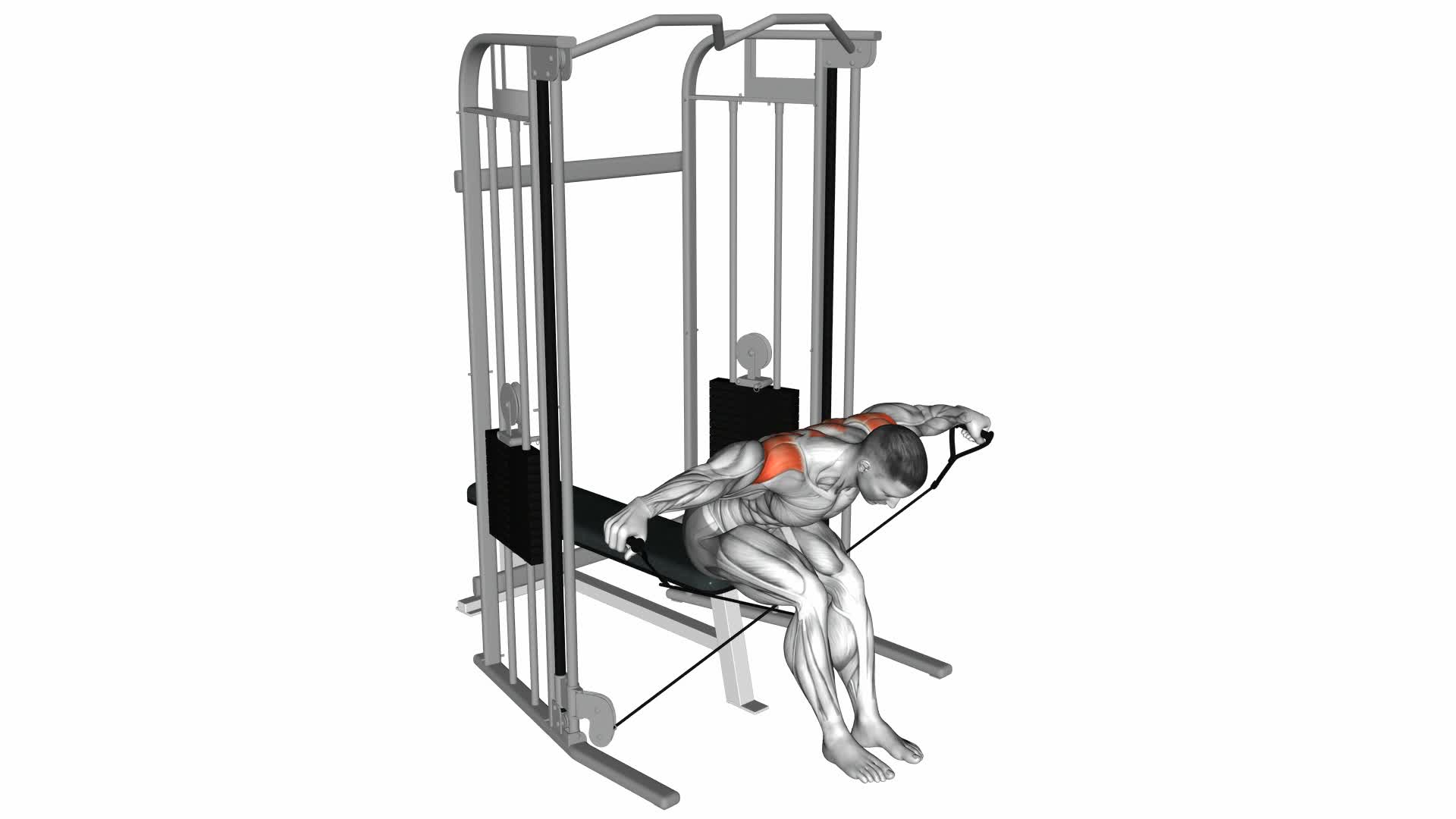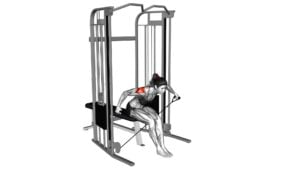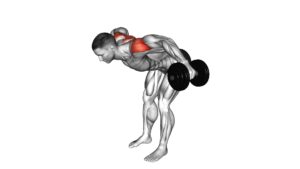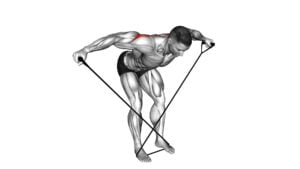Cable Seated Rear Lateral Raise – Video Exercise Guide & Tips

Looking to strengthen your shoulders and improve your upper body strength? Look no further than the cable seated rear lateral raise.
Watch This Exercise Video
This exercise targets your rear deltoids and helps to sculpt and define your shoulders.
In this video exercise guide, we will walk you through the proper form and technique, common mistakes to avoid, variations and modifications, and tips for getting the most out of this exercise.
Get ready to take your shoulder workout to the next level!
Key Takeaways
- Cable seated rear lateral raise targets and strengthens the shoulder muscles, specifically the rear deltoids.
- Proper form and technique, such as focusing on shoulder blade activation and controlling cable tension, are crucial for maximizing the benefits of this exercise.
- The exercise helps improve overall upper body strength, posture, and stability of the shoulder joints.
- When performing cable seated rear lateral raises, it is important to avoid common mistakes such as using excessive weight, shrugging the shoulders, or swinging the body.
Benefits of Cable Seated Rear Lateral Raise
You can experience several benefits from performing the Cable Seated Rear Lateral Raise exercise. This exercise specifically targets the shoulder muscles, providing a great way to activate and strengthen them. The cable seated rear lateral raise is an effective exercise for isolating the rear deltoids, which are the muscles responsible for moving the arms away from the body. By performing this exercise, you can enhance the strength and stability of your shoulder joints, improving your overall upper body strength and posture.
One of the key benefits of the cable seated rear lateral raise is the activation of the shoulder muscles. This exercise effectively targets the rear deltoids, helping to build strength and size in this often neglected area. Strong rear deltoids not only contribute to a well-balanced physique but also help to improve shoulder stability and reduce the risk of injury.
In addition to shoulder muscle activation, the cable seated rear lateral raise also helps to improve posture. As the exercise targets the rear deltoids, it also engages the muscles in the upper back, promoting better alignment and reducing the risk of rounded shoulders. By strengthening these muscles, you can improve your posture, which can have a positive impact on your overall appearance and reduce the risk of musculoskeletal imbalances.
Transitioning into the subsequent section about proper form and technique for the cable seated rear lateral raise, it's important to ensure that you perform the exercise correctly to maximize its benefits and avoid injury.
Proper Form and Technique for Cable Seated Rear Lateral Raise
To perform the cable seated rear lateral raise with proper form and technique, there are two key points to focus on:
- Shoulder blade activation: Start by sitting tall, engaging your core, and retracting your shoulder blades. This will help to stabilize your upper body and ensure that you are properly engaging the targeted muscles during the exercise.
- Cable tension control: Throughout the exercise, maintain control over the tension in the cables. This means that you should be using your shoulder muscles to raise the weight, rather than relying on momentum or excessive force. By controlling the tension, you can ensure that you are effectively targeting the intended muscles and minimizing the risk of injury.
Shoulder Blade Activation
Activate your shoulder blades correctly during the cable seated rear lateral raise exercise to ensure proper form and technique. Shoulder blade activation is essential for shoulder mobility and scapular stability.
Here are five tips to help you activate your shoulder blades effectively:
- Start by sitting upright with your chest lifted and shoulders relaxed.
- Squeeze your shoulder blades together as you initiate the movement, feeling a slight pinch in your upper back.
- Keep your shoulders down and away from your ears throughout the exercise.
- Engage your core to maintain stability and prevent excessive arching of the lower back.
- Control the movement and avoid using momentum, focusing on the contraction of the rear deltoids.
By following these tips, you'll optimize your shoulder blade activation and enhance the effectiveness of the cable seated rear lateral raise exercise.
Now let's move on to the next section, where we'll discuss cable tension control.
Cable Tension Control
To properly control the cable tension during the seated rear lateral raise exercise, it's important to maintain a steady and controlled movement throughout the entire range of motion. Cable tension control refers to the ability to adjust and regulate the resistance provided by the cables during the exercise. This is crucial for achieving optimal muscle activation and effectively targeting the muscles of the posterior shoulder and upper back.
To control the tension, start by selecting an appropriate weight on the cable machine. Begin the exercise by sitting upright with your feet firmly planted on the ground and your core engaged. Hold onto the cable handles with a neutral grip and keep your arms slightly bent. Slowly raise your arms out to the sides, squeezing your shoulder blades together as you lift. Avoid using momentum and focus on maintaining tension in the muscles throughout the movement.
As you progress in your training, you can adjust the cable tension by increasing or decreasing the weight on the machine to continue challenging your muscles and promoting growth and strength development.
Common Mistakes to Avoid During Cable Seated Rear Lateral Raise
You should avoid these common mistakes when performing the Cable Seated Rear Lateral Raise. Proper shoulder alignment is crucial in order to effectively target the muscles and prevent injury. Here are five common mistakes to avoid:
- Shrugging the shoulders: It's important to keep your shoulders relaxed and avoid lifting them towards your ears. This can put unnecessary strain on the neck and traps, taking away from the targeted muscle engagement.
- Using excessive weight: Using too much weight can compromise form and lead to poor shoulder alignment. Start with a lighter weight and focus on proper technique before increasing the load.
- Swinging the body: Avoid using momentum to lift the weight. Keep your torso stable and engage your shoulder muscles to perform the movement.
- Leaning too far forward or backward: Maintain an upright posture throughout the exercise. Leaning too far forward or backward can alter the angle of the movement and reduce the effectiveness of the exercise.
- Raising the arms too high: Avoid lifting your arms higher than shoulder level. This can cause strain on the rotator cuff and potentially lead to injury. Focus on a controlled and smooth movement within a comfortable range of motion.
Variations and Modifications for Cable Seated Rear Lateral Raise
When it comes to variations and modifications for the cable seated rear lateral raise, there are a few key points to keep in mind.
Firstly, optimal weight selection is crucial to ensure that you're challenging your muscles without sacrificing form.
Secondly, it's important to maintain proper form and technique throughout the exercise, focusing on squeezing your shoulder blades together and keeping your arms straight and parallel to the ground.
Optimal Weight Selection
Selecting the appropriate weight for cable seated rear lateral raises requires careful consideration of your individual capabilities and goals. Finding the optimal weight will ensure effective shoulder muscle activation and help you achieve the desired results.
Here are some factors to keep in mind when selecting the weight:
- Start with a lighter weight to focus on proper form and technique.
- Gradually increase the weight as your strength and proficiency improve.
- Choose a weight that challenges you without sacrificing form.
- Listen to your body and adjust the weight accordingly to avoid strain or injury.
- Remember that it's better to start lighter and progress gradually rather than using excessive weight and compromising your form.
By selecting the right weight, you can maximize the benefits of cable seated rear lateral raises.
Now let's move on to discussing proper form and technique for this exercise.
Proper Form and Technique
To perform cable seated rear lateral raises with proper form and technique, incorporate variations and modifications for optimal shoulder muscle activation and results. Proper form is crucial to avoid common errors and maximize the benefits of shoulder exercises.
Start by sitting on a bench with your back straight and feet flat on the floor. Grasp the handles of the cable machine with an overhand grip. Keep your arms slightly bent and raise them out to the sides until they're parallel to the floor.
Maintain control and squeeze your shoulder blades together at the top of the movement. Slowly lower the weights back down to the starting position. By using proper form and technique, you can target the rear deltoids effectively and prevent injury.
Now let's move on to some tips for getting the most out of cable seated rear lateral raises.
Tips for Getting the Most Out of Cable Seated Rear Lateral Raise
Maximize your results by incorporating proper form and technique into your cable seated rear lateral raise. To get the most out of this exercise, follow these tips:
- Adjust the cable machine: Make sure the cable is set at an appropriate height for your seated position. This will allow for a full range of motion and target the rear delts effectively.
- Maintain proper posture: Sit with your back straight and your core engaged. Avoid slouching or leaning forward, as this can put unnecessary strain on your lower back.
- Start with lighter weights: Begin with a weight that allows you to perform the exercise with proper form. As you become more comfortable and confident, gradually increase the weight.
- Focus on the mind-muscle connection: Concentrate on squeezing your shoulder blades together as you lift the weight. This will help to engage the rear delts more effectively.
- Control the movement: Avoid using momentum to swing the weight up. Instead, focus on controlled, slow and deliberate movements to fully engage the targeted muscles.
By following these tips, you can ensure that you're getting the most out of your cable seated rear lateral raise.
Remember to listen to your body and adjust the weights and intensity as needed.
Happy lifting!
Sample Workout Routine Incorporating Cable Seated Rear Lateral Raise
To incorporate cable seated rear lateral raise into your workout routine, consider adding it as a compound exercise. This exercise targets your rear deltoids, upper back, and trapezius muscles, making it an excellent addition to your upper body workout. By incorporating cable seated rear lateral raise into your routine, you can enhance muscle activation and promote overall muscle development.
To begin, set up a cable machine with the cable at shoulder height. Sit on a bench facing away from the machine, and grip the handles with an overhand grip. Start with your arms extended in front of you, palms facing down. Keep your chest up and your core engaged throughout the exercise.
To perform the movement, slowly raise your arms out to the sides, maintaining a slight bend in your elbows. Keep your shoulders down and avoid shrugging them. Pause for a moment at the top of the movement, then slowly lower your arms back to the starting position.
To modify this exercise, you can adjust the weight on the cable machine or use different attachments to target specific muscles. Additionally, you can vary the tempo of the movement, focusing on slower, controlled repetitions to increase muscle activation.
Incorporating cable seated rear lateral raise into your workout routine can help improve your posture, strengthen your upper back, and enhance shoulder stability. Remember to always use proper form and consult with a fitness professional before attempting any new exercises.
Frequently Asked Questions
How Many Repetitions and Sets Should I Do for Cable Seated Rear Lateral Raises?
For cable seated rear lateral raises, the number of repetitions and sets can vary depending on your fitness goals and current fitness level.
It's generally recommended to perform 8-12 repetitions for each set, and complete 2-3 sets of this exercise.
However, you can also modify the number of repetitions and sets based on your personal preferences and abilities.
Remember to adjust the weight accordingly to challenge your muscles and maintain proper form throughout the exercise.
Can I Use Dumbbells Instead of a Cable Machine for This Exercise?
Yes, you can modify the cable seated rear lateral raise exercise by using dumbbells instead of a cable machine. This variation allows you to target the same muscles while using a different equipment.
To perform the exercise with dumbbells, sit on a bench with your back straight and hold the dumbbells in your hands. Then, raise your arms to the sides until they're parallel to the floor.
Remember to maintain proper form and control throughout the movement.
Is It Necessary to Use a Bench While Performing Cable Seated Rear Lateral Raises?
Using a bench for cable seated rear lateral raises can offer several benefits. It provides stability and support for your back, allowing you to maintain proper form throughout the exercise.
Additionally, the bench helps to isolate the targeted muscles in your shoulders and upper back, enhancing the effectiveness of the exercise.
While variations of cable seated rear lateral raises can be performed without a bench, incorporating one can greatly enhance your workout and maximize your results.
Can I Do This Exercise Standing up Instead of Seated?
Yes, you can do the cable seated rear lateral raise exercise standing up instead of seated. This allows for a different range of motion and engages your core muscles more.
However, performing the exercise seated provides stability and support, especially for beginners.
Using a cable machine has its benefits, such as providing constant tension throughout the movement and targeting your rear deltoids effectively.
It's important to maintain proper form and control regardless of whether you're standing or seated.
What Muscles Does the Cable Seated Rear Lateral Raise Target?
The cable seated rear lateral raise primarily targets your rear deltoids, which are the muscles at the back of your shoulders. This exercise is great for building strength and definition in your shoulders, improving your posture, and enhancing overall upper body stability.
To perform the cable seated rear lateral raise with proper form, ensure that you maintain a slight bend in your elbows and avoid using momentum to lift the weights. Focus on squeezing your shoulder blades together as you lift the cables.
Conclusion
In conclusion, the cable seated rear lateral raise is a highly effective exercise for targeting and strengthening the rear deltoid muscles.
By maintaining proper form and technique, avoiding common mistakes, and incorporating variations and modifications, you can maximize the benefits of this exercise.
Additionally, following the tips provided and incorporating the cable seated rear lateral raise into your workout routine can help you achieve your fitness goals.
So, give this exercise a try and experience the results for yourself.

Author
Years ago, the spark of my life’s passion ignited in my mind the moment I stepped into the local gym for the first time. The inaugural bead of perspiration, the initial endeavor, the very first surge of endorphins, and a sense of pride that washed over me post-workout marked the beginning of my deep-seated interest in strength sports, fitness, and sports nutrition. This very curiosity blossomed rapidly into a profound fascination, propelling me to earn a Master’s degree in Physical Education from the Academy of Physical Education in Krakow, followed by a Sports Manager diploma from the Jagiellonian University. My journey of growth led me to gain more specialized qualifications, such as being a certified personal trainer with a focus on sports dietetics, a lifeguard, and an instructor for wellness and corrective gymnastics. Theoretical knowledge paired seamlessly with practical experience, reinforcing my belief that the transformation of individuals under my guidance was also a reflection of my personal growth. This belief holds true even today. Each day, I strive to push the boundaries and explore new realms. These realms gently elevate me to greater heights. The unique combination of passion for my field and the continuous quest for growth fuels my drive to break new ground.







